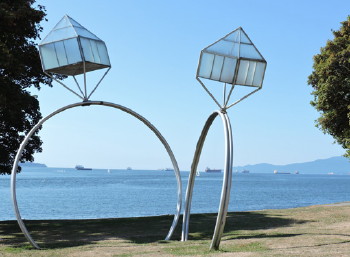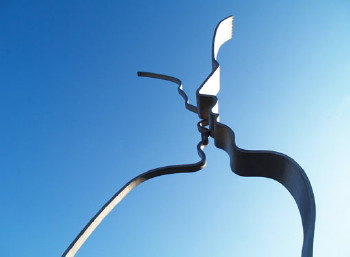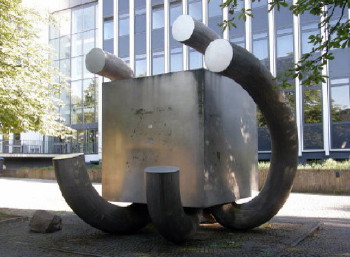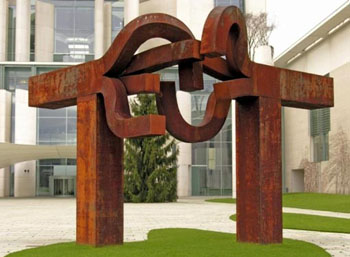Artist:
Brigitte and Martin Matschinsky-Denninghoff
Title:
Berlin
Year:
1985
Adress:
Tauentzienstrasse
Gently approaching each other
I’ve seen Berlin by Matschinsky-Denninghoff (Berlin, picture 2, more information) many times and for me it’s a precious artwork. I see two shiny forms which are carefully approaching each other from a large distance and meet each other very closely. The curvature makes clear that the connection is becoming (not breaking); the lines are in the process of moving towards each other.
With the use of simple tools Berlin by Matschinsky-Denninghoff is expressing a powerful message: a process of connection is happening. Because the artwork is located on a major road in the centre of Berlin, it is inevitable that it’s about meeting East- and West-Germany. Yet the universal visual language makes clear that many other connections are expressed.
By Theo, www.artatsite.com
Unification
Shape
The artwork consists of two large curved shapes which almost touch each others ends. The artwork is so large that it dominates the boulevard.
Material
After a close watch, the forms turn out to be a shiny perfectly round shape with a fine structure of lines.
Location
The sculpture stands on a green line in a centale boulevard in the center of city. Inhabitants of Berlin are walking underneath, sitting along side on a bench and let there children play. The statue is part of the social life in the city.
Impact
The forms have some reference to persons. It seems to me that the persons are about to embrace. The ends of the round shapes seem to 'look at each other.' This wakes up emotions in me of desire and tenderness. The artwork can also refer to two links which are open, but wherein the compound is not broken. This recalls rather the feeling of tension.
Meaning
The statue refers to the unification of East- and West-Berlin on a gentle way. This is a powerful artwork with multiple and important meanings referring to a crucial historical moment. It will remain meaningful because of the multiple possible ways to interpret the artwork.
By Theo, www.artatsite.com
Compared with other artworks
The artwork Joie de Vivre by Mark di Suvero (New York, picture 1, more information) makes use of practical components (structural steel), it expresses a sense of joy or even victory in a convincing way.
Although this artwork by Dennis Oppenheimer is entitled Engagement (Hong Kong, picture 2, more information), I think this artwork rather indicates of two people with a similar nature that are next to each other instead of connected with each other.
As the title Kiss by Jeroen Henneman (Amsterdam, picture 3, more information) suggests two people meet each other in a loving way. Because the forms are specific, this can only refer to this kind of specific happenings. That’s way the artwork don’t have to power to give meaning to other kind of experiences.
Grosser Würfel is another work by Brigitte and Martin Matschinsky-Denninghoff (Berlin, picture 4, more information) which shows how strong the visual language is of the couple. Here, the round shape is combined with a cube. This minimalist element is in conjunction with embracing forms. This artwork evokes in me the feeling of cherishing something precious.
Comparing continued
The first thing I see in Connection 3 by Jan Baetsen (Deventer, picture 5, more information) is a playful turning line. This line connects two rectangles which are standing upright. I can imagine that this artwork is about connecting. ‘Connecting’ is a nice word; this is needed always and ever again.
I do not fully understand why the surface of Connection 3 by Jan Beatsen has different colours. Because of the comparison with a work by Chillida, Matschinky-Denninghoff and De Vries I now see that the work by Jan Baetsen is too static. I miss the desire, now the connection is finished.
In Berlin by Eduardo Chillida (Berlin, picture 6, more information) two almost similar shapes meet each other. They stand on a sturdy leg. Their fingers are sticking forward and some of them seem to find each other (almost). The rusty surface indicates that the elements have a long experience.
The artwork has many tensions: because of the (minor) differences between the forms, because of the thick and thin lines, because of lines which almost touch each other.
Berlin by Eduardo Chillida makes me feel the troubles when solid elements meet on a gentle way. If the sculpture is to indicate pain, trouble, but also a lasting desire, then this artwork is well realized.
By Theo, www.artatsite.com
Auke de Vries is making with Maasbeeld (Rotterdam, picture 7, more information) connections between elements that have seemingly nothing in common. I see a ball, a rod, a cube, a curled shape. The shapes tilt, bow, swivel or turn.
This playful and exciting sculpture makes clear what is needed in the city. This artwork is a good addition to a city like Rotterdam, where above all there is al lot of hard-working, dealerships, functionality.
By Theo, www.artatsite.com
Vertaling
Elkaar voorzichtig naderen
Berlin van Matschinsky-Denninghoff heb ik al vele keren gezien en is voor mij een dierbaar kunstwerk. Ik zie twee glimmende vormen die elkaar voorzichtig naderen van grote afstand en elkaar héél dicht naderen. Door de kromming is duidelijk dat de verbinding tot stand komt (niet verbroken wordt); de lijnen zijn bezig om naar elkaar toe te bewegen.
Met eenvoudige hulpmiddelen drukt Berlin van Matschinsky-Denninghoff een krachtige boodschap uit: een verbinding wordt gemaakt. Doordat het kunstwerk op een belangrijke weg in het centrum van Berlijn staat, handelt het onvermijdelijk over Oost- en West-Duitsland. Toch maakt de universele beeldtaal duidelijk dat veel andere verbindingen uitgedrukt worden.
Door Theo, www.artatsite.com
Vergelijking met andere werken
Bij Verbinding 3 van Jan Baetsen (Deventer, afbeelding 5,meer informatie) zie ik allereerst een speels draaiende lijn. Deze lijn verbindt twee rechthoeken die rechtop staan. Ik kan mij voorstellen dat het kunstwerk over verbinden gaat. ‘Verbinden’ is een mooi woord; dit is altijd en steeds weer nodig.
Ik snap niet zo goed waarom het oppervlakte van Verbinding 3 van Jan Baetsen verschillende kleurvlakken heeft. Door de vergelijking met een werk van Chillida, Matschinky-Denninghoff en De Vries zie ik nu dat het werk van Jan Baetsen te statisch is. Doordat de verbinding tot stand is gebracht ontbreekt het verlangen ernaar.
Bij Berlin van Eduardo Chillida (Berlin, afbeelding 6,meer informatie) ontmoeten twee vergelijkbare vormen elkaar. Zij staan op een stevig been. Hun vingers steken vooruit en enkelen vinden elkaar ook (bijna). Het verroeste oppervlakte duidt erop dat de elementen doorleeft zijn.
In het kunstwerk zijn er veel spanningen: door de (kleine) verschillen tussen de vormen, door de dikke en dunne lijnen, doordat lijnen elkaar nét niet raken.
Berlin van Eduardo Chillida maakt de moeite invoelbaar als stevige elementen elkaar op een zachte manier ontmoeten. Als het beeld wil wijzen op pijn, moeite maar ook een duurzaam verlangen, dan is dit kunstwerk goed geslaagd.
Door Theo, www.artatsite.com
Auke de Vries legt met Maasbeeld (Rotterdam, afbeelding 7,meer informatie) verbindingen tussen elementen die schijnbaar niets met elkaar te maken hebben. Ik zie een bal, een staaf, een kubus, een gekrulde vorm. De vormen liggen op kiepen, buigen, draaien of kantelen.
Dit speelse en spannende sculptuur maakt duidelijk waar de stad behoefte aan heeft. Dit kunstwerk is een goede toevoeging in een stad als Rotterdam met veel hard-werken, handel drijven, functionaliteit.
Door Theo, www.artatsite.com
www.wikipedia.org:
Berlin is the name of a sculpture on theTauentzienstrasse in western Berlin, the capital of Germany.
First conceived in 1985 and unveiled by the husband-and-wife sculpting team of Brigitte Matschinsky-Denninghoff and Martin Matschinskyin 1987, the sculpture's principal motif, a"broken chain", was meant to symbolize the severed connections between West and East Berlin due to the construction of the Berlin Wall.
Even though the Wall has since been dismantled, the sculpture was bought by the city from Mrs. Matschinsky-Denninghoff to commemorate the unfortunate chapter in German history.
Berlin was one of eight sculptures designed during"Skulpturenboulevard Kurfürstendamm" (Boulevard of Sculptures: Kurfürstendamm), an event commissioned by the city of West Berlin to celebrate Berlin's 750th anniversary in 1987. Of the eight sculptures unveiled, three were allowed to remain past the anniversary year (Berlin, Pyramide, and Cadillacs in Form der nackten Maja); the city and Deutsche Bank acquired Berlin after its original lease had expired.
For the event, the sculptors were allowed free rein to decide where on or around the Kurfürstendamm to erect their work. The Matschinsky-Denninghoffs chose the Tauentzienstrasse in front of the Kaiser-Wilhelm-Gedächtniskirche, which was heavily damaged during the Bombing of Berlin in World War II, as the place to build and unveil their sculpture.
The sculpture consists of four steel tubes, each about 2 meters in diameter, reinforced with a concrete base, shooting upwards toward the sky. For about a half-meter, one of the two ends on each side tilt, then change direction completely, looping but not touching, symbolizing the closeness and isolation between the two sides of Berlin. In addition, the surface of the tubes are covered by chrome nickel steel, to give a sort of"glimmer effect" which can darken or shine depending on the time of day.
Describing the meaning and impact intended by the Berlin sculpture, Brigitte Matschinsky-Denninghoff said, "The sculpture is accessible from all sides and thus perceivable to viewers. [What is] emphasized is the direction West-East and East-West. Our sculpture is specifically designed as a big, 'organically grown' gate, forming a double arch which is not just necessary and practical, [but an] invigorating emphasis...we are trying to communicate something of Berlin's situation in a symbolic way."
www.ludorff.com:
Their dynamically dissolved, sculptural bodies, with which they began in the mid-1950s, were subject to constant, solid, technical and formal-aesthetic law and regularity. Similar to Norbert Kricke's work, but more voluminous, her works appear as spatial drawings that exemplify the aesthetically visible contradictions between open and closed, gravity and weightlessness. The metal sculptures negotiate the space surrounding them in almost arbitrarily variable dimensions and formats.
www.wikipedia.org:
Martin Matschinsky (b. 4 July 1921, Grötzingen, Karlsruhe, Baden — 24 January 2020, Berlin) and Brigitte Matschinsky-Denninghoff (born Meier-Denninghoff; 2 June 1921, Berlin — 11 April 2011, Berlin) were a German artist-couple known for their monumental abstract sculptures.
I’ve seen Berlin by Matschinsky-Denninghoff (Berlin, picture 2, more information) many times and for me it’s a precious artwork. I see two shiny forms which are carefully approaching each other from a large distance and meet each other very closely. The curvature makes clear that the connection is becoming (not breaking); the lines are in the process of moving towards each other.
With the use of simple tools Berlin by Matschinsky-Denninghoff is expressing a powerful message: a process of connection is happening. Because the artwork is located on a major road in the centre of Berlin, it is inevitable that it’s about meeting East- and West-Germany. Yet the universal visual language makes clear that many other connections are expressed.
By Theo, www.artatsite.com
Unification
Shape
The artwork consists of two large curved shapes which almost touch each others ends. The artwork is so large that it dominates the boulevard.
Material
After a close watch, the forms turn out to be a shiny perfectly round shape with a fine structure of lines.
Location
The sculpture stands on a green line in a centale boulevard in the center of city. Inhabitants of Berlin are walking underneath, sitting along side on a bench and let there children play. The statue is part of the social life in the city.
Impact
The forms have some reference to persons. It seems to me that the persons are about to embrace. The ends of the round shapes seem to 'look at each other.' This wakes up emotions in me of desire and tenderness. The artwork can also refer to two links which are open, but wherein the compound is not broken. This recalls rather the feeling of tension.
Meaning
The statue refers to the unification of East- and West-Berlin on a gentle way. This is a powerful artwork with multiple and important meanings referring to a crucial historical moment. It will remain meaningful because of the multiple possible ways to interpret the artwork.
By Theo, www.artatsite.com
Compared with other artworks
The artwork Joie de Vivre by Mark di Suvero (New York, picture 1, more information) makes use of practical components (structural steel), it expresses a sense of joy or even victory in a convincing way.
Although this artwork by Dennis Oppenheimer is entitled Engagement (Hong Kong, picture 2, more information), I think this artwork rather indicates of two people with a similar nature that are next to each other instead of connected with each other.
As the title Kiss by Jeroen Henneman (Amsterdam, picture 3, more information) suggests two people meet each other in a loving way. Because the forms are specific, this can only refer to this kind of specific happenings. That’s way the artwork don’t have to power to give meaning to other kind of experiences.
Grosser Würfel is another work by Brigitte and Martin Matschinsky-Denninghoff (Berlin, picture 4, more information) which shows how strong the visual language is of the couple. Here, the round shape is combined with a cube. This minimalist element is in conjunction with embracing forms. This artwork evokes in me the feeling of cherishing something precious.
Comparing continued
The first thing I see in Connection 3 by Jan Baetsen (Deventer, picture 5, more information) is a playful turning line. This line connects two rectangles which are standing upright. I can imagine that this artwork is about connecting. ‘Connecting’ is a nice word; this is needed always and ever again.
I do not fully understand why the surface of Connection 3 by Jan Beatsen has different colours. Because of the comparison with a work by Chillida, Matschinky-Denninghoff and De Vries I now see that the work by Jan Baetsen is too static. I miss the desire, now the connection is finished.
In Berlin by Eduardo Chillida (Berlin, picture 6, more information) two almost similar shapes meet each other. They stand on a sturdy leg. Their fingers are sticking forward and some of them seem to find each other (almost). The rusty surface indicates that the elements have a long experience.
The artwork has many tensions: because of the (minor) differences between the forms, because of the thick and thin lines, because of lines which almost touch each other.
Berlin by Eduardo Chillida makes me feel the troubles when solid elements meet on a gentle way. If the sculpture is to indicate pain, trouble, but also a lasting desire, then this artwork is well realized.
By Theo, www.artatsite.com
Auke de Vries is making with Maasbeeld (Rotterdam, picture 7, more information) connections between elements that have seemingly nothing in common. I see a ball, a rod, a cube, a curled shape. The shapes tilt, bow, swivel or turn.
This playful and exciting sculpture makes clear what is needed in the city. This artwork is a good addition to a city like Rotterdam, where above all there is al lot of hard-working, dealerships, functionality.
By Theo, www.artatsite.com
Vertaling
Elkaar voorzichtig naderen
Berlin van Matschinsky-Denninghoff heb ik al vele keren gezien en is voor mij een dierbaar kunstwerk. Ik zie twee glimmende vormen die elkaar voorzichtig naderen van grote afstand en elkaar héél dicht naderen. Door de kromming is duidelijk dat de verbinding tot stand komt (niet verbroken wordt); de lijnen zijn bezig om naar elkaar toe te bewegen.
Met eenvoudige hulpmiddelen drukt Berlin van Matschinsky-Denninghoff een krachtige boodschap uit: een verbinding wordt gemaakt. Doordat het kunstwerk op een belangrijke weg in het centrum van Berlijn staat, handelt het onvermijdelijk over Oost- en West-Duitsland. Toch maakt de universele beeldtaal duidelijk dat veel andere verbindingen uitgedrukt worden.
Door Theo, www.artatsite.com
Vergelijking met andere werken
Bij Verbinding 3 van Jan Baetsen (Deventer, afbeelding 5,meer informatie) zie ik allereerst een speels draaiende lijn. Deze lijn verbindt twee rechthoeken die rechtop staan. Ik kan mij voorstellen dat het kunstwerk over verbinden gaat. ‘Verbinden’ is een mooi woord; dit is altijd en steeds weer nodig.
Ik snap niet zo goed waarom het oppervlakte van Verbinding 3 van Jan Baetsen verschillende kleurvlakken heeft. Door de vergelijking met een werk van Chillida, Matschinky-Denninghoff en De Vries zie ik nu dat het werk van Jan Baetsen te statisch is. Doordat de verbinding tot stand is gebracht ontbreekt het verlangen ernaar.
Bij Berlin van Eduardo Chillida (Berlin, afbeelding 6,meer informatie) ontmoeten twee vergelijkbare vormen elkaar. Zij staan op een stevig been. Hun vingers steken vooruit en enkelen vinden elkaar ook (bijna). Het verroeste oppervlakte duidt erop dat de elementen doorleeft zijn.
In het kunstwerk zijn er veel spanningen: door de (kleine) verschillen tussen de vormen, door de dikke en dunne lijnen, doordat lijnen elkaar nét niet raken.
Berlin van Eduardo Chillida maakt de moeite invoelbaar als stevige elementen elkaar op een zachte manier ontmoeten. Als het beeld wil wijzen op pijn, moeite maar ook een duurzaam verlangen, dan is dit kunstwerk goed geslaagd.
Door Theo, www.artatsite.com
Auke de Vries legt met Maasbeeld (Rotterdam, afbeelding 7,meer informatie) verbindingen tussen elementen die schijnbaar niets met elkaar te maken hebben. Ik zie een bal, een staaf, een kubus, een gekrulde vorm. De vormen liggen op kiepen, buigen, draaien of kantelen.
Dit speelse en spannende sculptuur maakt duidelijk waar de stad behoefte aan heeft. Dit kunstwerk is een goede toevoeging in een stad als Rotterdam met veel hard-werken, handel drijven, functionaliteit.
Door Theo, www.artatsite.com
www.wikipedia.org:
Berlin is the name of a sculpture on theTauentzienstrasse in western Berlin, the capital of Germany.
First conceived in 1985 and unveiled by the husband-and-wife sculpting team of Brigitte Matschinsky-Denninghoff and Martin Matschinskyin 1987, the sculpture's principal motif, a"broken chain", was meant to symbolize the severed connections between West and East Berlin due to the construction of the Berlin Wall.
Even though the Wall has since been dismantled, the sculpture was bought by the city from Mrs. Matschinsky-Denninghoff to commemorate the unfortunate chapter in German history.
Berlin was one of eight sculptures designed during"Skulpturenboulevard Kurfürstendamm" (Boulevard of Sculptures: Kurfürstendamm), an event commissioned by the city of West Berlin to celebrate Berlin's 750th anniversary in 1987. Of the eight sculptures unveiled, three were allowed to remain past the anniversary year (Berlin, Pyramide, and Cadillacs in Form der nackten Maja); the city and Deutsche Bank acquired Berlin after its original lease had expired.
For the event, the sculptors were allowed free rein to decide where on or around the Kurfürstendamm to erect their work. The Matschinsky-Denninghoffs chose the Tauentzienstrasse in front of the Kaiser-Wilhelm-Gedächtniskirche, which was heavily damaged during the Bombing of Berlin in World War II, as the place to build and unveil their sculpture.
The sculpture consists of four steel tubes, each about 2 meters in diameter, reinforced with a concrete base, shooting upwards toward the sky. For about a half-meter, one of the two ends on each side tilt, then change direction completely, looping but not touching, symbolizing the closeness and isolation between the two sides of Berlin. In addition, the surface of the tubes are covered by chrome nickel steel, to give a sort of"glimmer effect" which can darken or shine depending on the time of day.
Describing the meaning and impact intended by the Berlin sculpture, Brigitte Matschinsky-Denninghoff said, "The sculpture is accessible from all sides and thus perceivable to viewers. [What is] emphasized is the direction West-East and East-West. Our sculpture is specifically designed as a big, 'organically grown' gate, forming a double arch which is not just necessary and practical, [but an] invigorating emphasis...we are trying to communicate something of Berlin's situation in a symbolic way."
www.ludorff.com:
Their dynamically dissolved, sculptural bodies, with which they began in the mid-1950s, were subject to constant, solid, technical and formal-aesthetic law and regularity. Similar to Norbert Kricke's work, but more voluminous, her works appear as spatial drawings that exemplify the aesthetically visible contradictions between open and closed, gravity and weightlessness. The metal sculptures negotiate the space surrounding them in almost arbitrarily variable dimensions and formats.
www.wikipedia.org:
Martin Matschinsky (b. 4 July 1921, Grötzingen, Karlsruhe, Baden — 24 January 2020, Berlin) and Brigitte Matschinsky-Denninghoff (born Meier-Denninghoff; 2 June 1921, Berlin — 11 April 2011, Berlin) were a German artist-couple known for their monumental abstract sculptures.










